The sat phone war, “independent study” edition
That diabolical test machine is forcing a measured, if destructive, twist into an Iridium 9555 satellite phone, which may be a good metaphor for what Inmarsat had in mind when it commissioned an independent study comparing its Isatphone Pro to the 9555 as well as the Thuraya XT (which doesn’t cover the Americas). After all, there had already been crowing about another “independent study” that turned out to be commissioned by Iridium (downloadable here). Now it’s very easy to be cynical about studies that each find the hardware and service offered by the company that sponsored their efforts to be superior, but actually I found both reports to be largely credible and quite useful…
In fact, anyone shopping for a sat phone would be wise to read both studies as they’re full of valuable details about the specific service and hardware technologies (while most anyone may enjoy the Inmarsat-commissioned video, if only that it’s so very British). And I was impressed that the reports, for the most part, correspond to what I found testing both the iSatphone Pro and the Iridium 9555 (but note that my testing was quite limited and not simultaneous). For instance, both reached similar conclusions about comparative start-up times, though the Inmarsat-sponsored one suggested that the iSatphone’s slowness might be improved with a future software update.
While the studies have worth, neither deals with the specific issues of boats. I’m particularly wondering if the iSatphone Pro’s pointing needs on start up are a real problem on a rolling yacht. I know that sat phone expert Luis Soltero was concerned about that, though he told me that the docks his company sells take care of that problem neatly (though while also negating the hardware cost differential). It would be great to hear from anyone who’s tried the Inmarsat phone at sea, as well as what you all think of those studies.


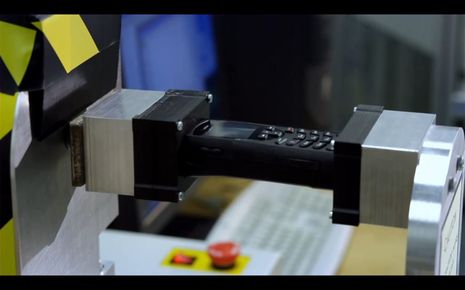
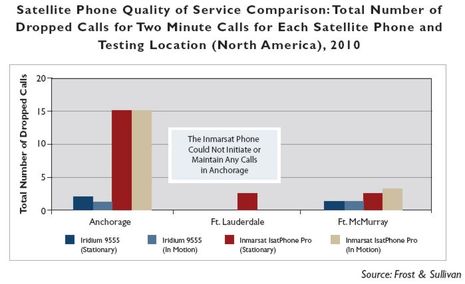
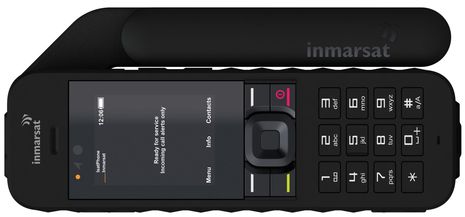
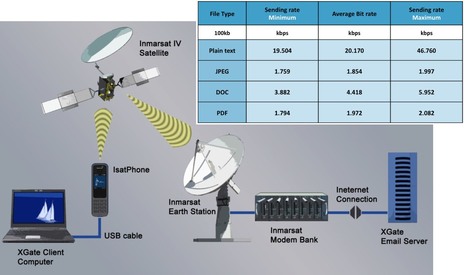
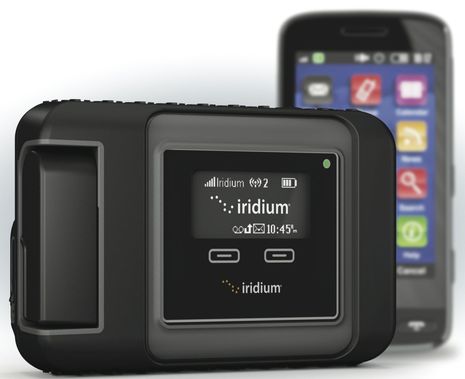
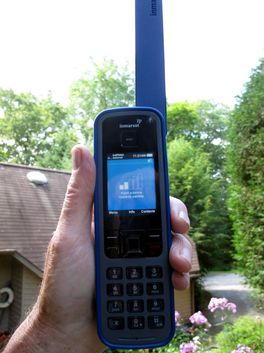







I have used the iSatphone Pro on my boat at sea (off shore of southern California and northern Baja) without any difficulty establishing a connection. In fact, I was not aware of any special pointing needs, and therefore made no effort to hold the phone still, etc. I can’t remember how heavy the seas were, but my boat is 64 feet and stabilized, so I doubt it was the kind of storm conditions that the phone might have to function in during an emergency situation.
Rather than subscribing to a monthly plan (since I don’t use the phone even monthly), I purchased a pre-paid minutes card, which by its terms does not work “in the US”. I have not been able to determine what constitutes “in the US”, either by trial or by inquiry. I have had it work 15 miles off shore of California, but have also had it not work further offshore, but within about 10 miles of San Clemente island. My working hypothesis is that within 12 miles is regarded as in the US. Note I had a connection (as confirmed by sending a status inquiry and receiving a reply), it was just that my prepaid minutes wouldn’t work. Ben, perhaps with your resources, you can get a more definitive answer to the question of what constitutes “in the US”. I would imagine that the prepaid cards would be an attractive option to many boaters (incoming texts are free and the per minute cost is better that under the basic plans, and there is no monthly minimum; factoring the minimums, you have to use many minutes per month (in excess of 100, as I recall) to make a subscription plan worthwhile), even if their phone would only work “offshore”, since VHF and cell phones are an adequate alternative closer in. Also, there is a rumor that the restriction against use “in the US” is a regulatory issue, that is expected to be resolved in “early” 2011. Any truth to that?
Ben, an interesting and for me timely post as we are just about to pull the trigger on two phones: primary, either 9555 or iSatPhone with dock; secondary, iSatPhone for ditch bag.
Both units offer expensive Beam Communications docks with tracking capabilities, so the primary differentiators for us are: call quality (can’t tell much difference when docked); dropped call performance (the data above are interesting); hardware price (~$495 vs $1,075 for Inmarsat and Iridium, respectively); and per-minute price (~$0.95 vs $1.25); reliability (limited number of Inmarsat sats is a concern).
I did not include in that list the weight we put on each of those factors. In the end reliability is probably the most important; the initial cost difference is actually pretty meaningless in the grand scheme of things, but the per-minute cost is not. If Inmarsat had more than one bird in each geographic region I would definitely go with the iSatPhone as a primary but as it is I think that the many Iridium birds give that network the edge.
/afb
Thanks, Rick. Yes, I definitely heard last summer that the Inmarsat prepaid card issue in the U.S. was going to get solved. And I let both Luis Soltero of GMN and CJ Webber of the SatPhoneStore know about this entry, hoping they’ll bring us up to date. For light and/or occasional users, the card looks like a great deal.
By the way, you’re cruising in an area that is predictably friendly to the iSatphone Pro because you’re nearly underneath the big i4 Americas satellite. Less distance + less atmosphere = more signal.
Adam, I did once hear a competitor say that “Inmarsat is f**ked” if one of the i4 satellites blew up, but I think it’s unlikely and they may have a spare. At any rate, you’d still only have 33.3% chance of losing service as they operate independently. I don’t know how many failures the Iridium constellation can take as they pass data to each other, but obviously the safest strategy is one of each. But did you check out Iridium-based Cerebrus, which would give you two-way texting backup to Inmarsat and all sorts of other features neither phone offers (at least yet):
https://panbo.com/archives/2011/01/and_hello_cerberus_spot_connect_on_steroids.html
In the opion of current users, how does Globalstar fit into this equation?
Ben, I did see the Cerberus post. It looks interesting, especially since the SPOT I bought doesn’t work in the South Pacific. However, I kind of would like to wait for additional Iridium 9602 devices to be released rather than buying the first one on the market.
/afb
Rick, CJ Webber of the SatPhoneStore tells me that the prepaid card problem has to do with a company that has a US patent on it. Lawyers are talking but he doesn’t expect a fix until “a few more months at the soonest but most likely towards the end of the year.” Until then “Inmarsat will not offer prepaid service in the US unless they are 15 to 20 miles off the coast.” Meanwhile, Iridium is apparently using a different prepaid card technology that doesn’t involve the patent.
I have been talking to plenty of boaters who have purchased the IsatPhone Pro and the response has been positive. IsatPhone Pro in open waters not to far from the equator works beautifully. If you also plan to use the phone in mountainous terrain, in a city or travel to Alaska then spend a little extra on the Iridium 9555. Also if you plan to buy a dock and marine antenna go ahead and buy the Iridium marine package. It comes out to the same price as the IsatPhone Pro and dock but you get the better handheld network.
Inmarsat is currently working on prepaid in the US. They are up against a US. Company that holds the patent to their prepaid platform. Once this is resolved prepaid will work globally. This should be resolved by the end of the year. Having the prepaid work 15 to 20 miles off the coast seems to work for most boaters since that is about the range cell phones cut out. Right now we are offering IsatPhone Pro 110 or 260 minute prepaid card for $0.45 per minute at http://www.SatPhoneStore.com. That is a great deal for satellite minutes and the promo will be around for a few more months.
Ben, thank you for the information. I will test more carefully to see if I can discern a more precise rule about how far off shore constitutes “Not in US”. Since it boils down to a legal dispute, and since the phone provides its exact gps based position, I would think that Inmarsat could safely allow use at a distance from shore of only 3 NM (isn’t that the official boundary under international law?) plus a 100 foot margin of error.
CJ — thank you for your insights. I paid something like $0.85 per minute for my prepaid minutes and considered that a bargain. I might load up on some of those $0.45 minutes. Perhaps you could answer another question, regarding e-mails and texts. It appears that there is no practical way to send a text from a US phone — instead the sender must send the text through Inmarsat’s website. I have tried to explain to my wife and friends how to do that (which I encourage, since the incoming texts are free), but they find the process too cumbersome. I understand that there is an e-mail alternative, but can’t find it in the documentation. In particular, I don’t know how to get the SatPhone’s e-mail address. Any suggestions?
Thanks, Rick
According to CJ’s web site, that price is only good with the purchase of an iSatPhone. Since their price on the phone is about $100 higher than the cheapest I’ve seen, it seems like the cheap minutes deal only makes sense for the 260 min package.
Rick, I’m not sure I tried texting, but I had no trouble sending emails from and to the iSatphone Pro. I just found the test emails and can see that the phone’s address was its number @message.inmarsat.com as in:
[email protected]
It generally took a few minutes after activating the phone for the emails to show up, but they always did.
This is just a peripheral topic, but since you’re talking about Inmarsat, you really need to do an article about LightSquared and their potential to disrupt GPS receiver function due to an interference issue from the the Inmarsat component of their proposed 4G network plans.
I have waded through the recent FCC determination allowing them to proceed (with restrictions), and have also read the comments in opposition voiced by U.S. GPS Industry Council (dominated by Garmin):
http://www.gpsworld.com/gnss-system/news/data-shows-disastrous-gps-jamming-fcc-approved-broadcaster-11029
Wake-up, Ben.
Karl, while Ben is thinking about this, Inmarsat has no input into the Lightsquared deal other then receiving payments to release some L-Band spectrum that LS plans to use (for uplinks I think). Lightsquared is launching its own birds to provide an addition to it’s terrestrial 4g broadband plans as required to service less populated areas of the US.
I am aware of the LightSquared issue, Karl, but not worked up about it. If the LS transmitters truly mess up GPS — and I tend to believe the Garmin testing results, which are emphatic — it’s going to affect car and plane navigation, as well a smart phones, well before many boaters have a problem…and it will be fixed. Spectrum is a really big deal and it would be great to have an alternate blanket of wireless broadband across the U.S. (even if LS is run by an obnoxious man). But the companies that would howl if GPS is disrupted, not to mention the citizens, far outweigh LightSquared.
That’s what I think, and also just Tweeted. (That Tweet box above will probably be a permanent Panbo feature…because I’ve been getting way too much sleep 😉
I think you need need to work out what you need the phone for, they both offer advantages over each other depending on the users requirement. Lets face it Iridium is expensive and needs to generate income to replace there ageing fleet of satellites. Inmarsat, on the other hand, have 3 satellites and the cost is less and the fleet offer greater services ie BGAN. The BGAN terminals seem to work in Alaska and that maybe because the receivers and antenna are larger. While Thuraya don’t offer coverage in the US, there call costs in Europe are on par with Inmarsat’s, and the handset is smaller. Iridium are the only company that provide global coverage and you pay the premium for that, in handset costs and call costs. Incoming call issues are minor and i don’t know many people that make calls to them, due to the huge costs associated with it, most text the sat phone and the user calls back. I was interested to read about the quality of the isatphonepro and while it boast to be very rugged many reports suggest, to the user, the phone seems less durable. I currently use a small BGAN terminal, never had a problem with it, and its always worked, i had hoped to sell it and move to a small sat phone, but the market is still confusing and i don’t think one product solves my needs.
I’m reliably informed it is 12 Nautical miles that are considered to be still in the US; as you would expect as that is what is defined as “Territorial Waters”… http://en.wikipedia.org/wiki/Territorial_waters
I’ve successfully made calls from a Beam docked IsatPhone off the coast of Tasillaq, Greenland, so I’m not too concerned about the elevation angle on open sea.
A docked isatphonepro should always perform better than a handheld one. The antenna thats comes with the docks is more likely to be far better than the one on the handset. The further north or south you are from the equator the better the aerial will need to be.
I found my BGAN signal far better just north of the equator than i did back here in the UK.
If Iridium want to become more competitive than they really do need to lower the cost of the handsets and alter the pre-paid billing system, as it can be very expensive by comparison, in fact in most case 3 times as expensive.
Can anyone shed some light on the proposed “data” capability on the Isatphone? Everything seems to say 1Q2011. Will they meet that target? Will you need to buy some new accessory or will it be a firmware upgrade? Thanks!
Bob, I believe that Luis Soltero of GMN is testing it and plans to report when he’s done. I also have a meeting with Inmarsat tomorrow. Stand by, please.
I have the Isatphone and did try it in the middle of the ocean in the Caribbean. It did work however it took about 2 minuets to get a connection.. I would hate to be in an emergency which is a main reason for having the phone..
The phone will not send SMS nor will it send an email.. It seems that the folk at Isatphone are at a loss as to why.. I was assured during the purchase that this phone would do emails and SMS..
Also the emails that I receive are limited to the screen size, that is to say it will not scroll down to read the message in full. Or the whole of the message does not arrive.
If I hit the reply to an email or SMS it asks for the recipient. One would assume that reply means reply to the person whom sent the original. Not that it matters any as I get the message “Message send failed. Message undeliverable. Message format unsupported”
I am hoping that the next firmware upgrade may fix this if not it will be goodbye Isatphone and hello Iridium.
The isatphone does send emails but i think they are limited to the same characters as SMS messages due to the way they are routed. This will change when the data option of the isatphonepro is enabled, and you can connect your phone to your laptop and send, but i would imagine this is slower and more costly.
From the comments above it would seem that the isatphone struggles when the motion of ships and boats on the ocean. Maybe because of the way the phone obtains its signal and beam from the satellite. If this is the case then i really hope that it can be fixed. As i commented above the further north or south you are from the equator makes a huge difference to the signal levels. Its a shame that Thuraya dont cover the Americas.
I think you’re right, James; they are text messages that can be sent to email addresses. Arne I had no trouble with email or texts when I tested the phone last summer…
http://goo.gl/iMEDR
I learned yesterday that the PC connection is supposed to roll out on March 31, as a firmware update. But no one should think they can just fire up Outlook and do email. As with Iridium and Globalstar, the narrow band connection will work much better with a dedicated email service like xGate or OCENS mail.
Ben – It’s an extremely small “pipe” for data. I just want to download gribs, and only then where there is no other option to access data. Email will have to wait for a WiFi connection. If you can get feedback from Luis, that would be fantastic….
Arne – Sorry to hear you have had messaging issues. Do you have the latest firmware installed? I don’t plan to use email/SMS much, but I would expect it to work.
The 2 minute startup is something I think you have to live with. The GPS on a cold start has to figure out where you are. It’s not optimal, but “expected” given the technology. Still beats the HF radio that doesn’t fit in the ditch bag….at a lower cost than Iridium..for today at least.
The startup time is because the phone must have a GPS fix first before it will register to the network, the same applies to Inmarsat’s BGAN terminals, this can take up to 3 minutes from a new location. Both Thuraya and Inmarsat use GPS for similar reasons.
As a general rule you wont get a small telephone style handset that will provide sufficient bandwidth to allow emails and web browsing at any significant speed, even with some of the compression technologies, but if thats all you have then then it will work.
Inmarsat’s 3 Satellites are all in orbit with a life beyond 2020, the new ones launching in 2 years will have a 50mb link with smaller terminal size.
Iridium needs to start replacing its fleet of satellites and this is requires massive capitol, and that needs to come from somewhere, some from the bank and some from existing users, so i would not expect to see Iridium lower the handset costs or the airtime any time soon.
The isatphonepro is cheap, very cheap, and the call costs are almost the same as cell users, the handset is robust enough for even the most rugged user, the aerial is a bit big, but it needs to be.
I personally think the isatphonepro is a really winner for 95% of users, unless you can stomach the cost of using Iridium, and until Globalstar re-launch then it is really the only option for many users who want almost worldwide coverage.
If if you are going to the extremes of coverage then i suggest you look at the BGAN terminals, as the antenna are bigger and you stand a better chance of getting a signal. I know of one user who used his BGAN terminal in Alaska without any problems.
Bob, I am familiar with the small circuit switched 2.4bps pipe that an Iridium phone offers and you most definitely can do email, and GRIB downloads, with it, but it’s painful without also using software and services like xGate. I think Inmarsat has the same size pipe and so I would hope for the same results, but we shall see.
I guess I will find out. Iridium and Inmarsat Fleet services are out of my budget. So I will have a Isatphone Pro for critical needs.
But in addition, I am thinking about getting a used Globalstar GSP1600 for 150.00 and activating the 19.99/month unlimited service for a year. In theory at least, that will give me occasional windows for routine calls. Supposedly the available windows based on your geographic location are accurately predicted on the Globalstar website. For $400 first year costs, anything over about 500 minutes is “free” compared to paying for Isatphone Pro minutes. I also hope to use the data service, it’s supposedly a little faster.
I’d be interested if anyone has used Globalstar recently, my opinion above is the based on research. But there is little information I could find from users, especially recent.
Globalstar are on there way back into the marker, this has been greatly helped by the use of the simplex system that the network uses, and which is 100% functional. Devices like Spot Messenger and other such devices have helped Globalstar a great deal.
Once Globalstar get all the satellites into orbit i would imagine that they will market some pretty competitive deals on handsets and airtime. The good news is that it would seem that the new Globalstar network will be backwards compatible, with some of the older handsets.
The bottom lines is this, if you need a world wide pole to pole phone then Iridium is the only choice.
If you dont need a phone for the Americas then Thuraya is very competitive. There XT handset being the latest.
If you need a phone world wide and not pole to pole and you need cheaper communications then Inmarsat isatphonepro is for you.
If you need phone and internet then you only really have once choice and thats Inmarsats BGAN system that allows phone and data at the same time from a small terminal (Wideye Sabre 1)
If you need a phone cheaply with cheap costs and you will know roughly where you will be at a specific time then Globalstar is excellent value, there airtime is cheaper than most cell phone tariffs, but you dont have the immediate availability to make calls.
I have used Thuraya, Iridium and BGAN, Thuraya handsets (prior to XT) were very poorly made and not very robust, but the calls were cheap and coverage was great for me. Iridium was excellent the handset huge and the aerial as well, did make me feel a bit silly while i was using it sometimes, but it was robust, but call drops were high and call passing to the next satellite was hit and miss, disconnects usually around 15-20mins. I also on average 1 in 3 calls had to make several attempts after the continuous beep tone. BGAN has for me been the most versatile but the least portable. Easy to connect, easy to use, but data charges are huge! Voice calls are on par with other networks, but each MB of data was around 8 UK Pounds.
Arne, did you find a solution to your problem of not being able to send text messages or email? I have the same problem, and receiving the same exact error message when I try to send a message.
Please let me know is anyone knows of a solution to resolve this error. Thanks.
Hi Steve,
In reference to my post Feb 18 concerning the problem of sending/receiving text and emails.
The problem is now fixed. It turned out that there needs to be a phone number (+870772001799)to be activated.
These are the instructions:
If you are unable to send an SMS:
Press “Menu”, highlight “Messaging” and press “Select.”
Press the “Options” key.
Scroll to “Settings” and press “Select.”
Highlight “Text msg. setting” and press “Select.”
Highlight “SMSC management” and press “Select.”
Highlight “+870772001799” and press “Options,” select “Activate.”
Verify that your SMS Email center number is 456.
This should be stored on the SIM when it is delivered and the handset should use this value as the default. In very early DP release SIMs the value was +456 and this will cause the SMS Email send to fail. To verify this follow these steps:
Open Menu>Messaging>Options
Select Settings>Email settings
This will display a list of the stored Email centre numbers
If there is no stored value, or the value is +456, choose Select, highlight , choose Options>Edit, enter 456, choose Apply, The handset prompts the user: Choose Yes
Make sure you are using the correct format to send the SMS: It should be 00 .
I thank SatPhoneCity for the fix.